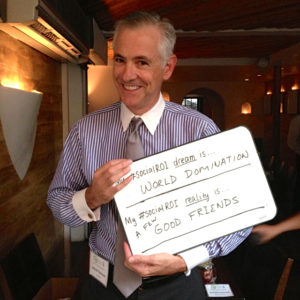This may be the last (no promises) in my recent series of interviews on Influencer Marketing. Fortunately for you, Matt Hixson, CEO of Tellagence, brings a different perspective on all this stuff since his company develops tools that help other companies identify and then engage communities. Stay thirsty my friends as this influencer marketing party is just beginning.
Drew: First, can you give me a brief overview of what Tellagence does?
Tellagence predicts how information moves across a social network and informs anyone responsible for a brand’s content and communication what should be shared within their audience. This is accomplished by unlocking complex behavior and dynamic relationships. We have built two products that help us do this. First, Tellagence Discover allows brands to identify an audience, their interests and their choice of words. Second, Tellagence Community allows you to identify the people who will not only engage on this subject but have the greatest potential to spread a message throughout this audience.
Drew: How would you define Influencer Marketing vis-a-vis Social Media marketing?
Social media has always been about WOM and the relationships needed to be successful. In the early days of online social networks it was simple because the number of users was much smaller. You could hustle and find the people you needed to reach. Influencer marketing is the ability to focus our resources on creating the one-on-one relationships that can significantly and predictably spread the message at scale and drive responses to our calls to action.
Drew: Can you give my readers an example of an Influencer Marketing program in which Tellagence played a role?
The value Tellagence provides is simple: we are able to find individuals who may not be considered an ‘influencer’ due to say a lack of or low follower count in Twitter, but instead play a critical role in how information moves across an online social network.
One of our earliest clients was an agency representing a large fortune 500 brand. They had a decent grasp on the client’s obvious network but we were able to identify a large group of people engaging around an important subject to the brand, which they were completely unaware of. As opposed to having them mass market to this entire group we were able to identify highly targeted individuals that were critical in how this group not only received information but passed it along to the large percentage of the community. These were people who had less than 100 followers and a low influencer score but were critical and would be overlooked by most.
Drew: How should brands be evaluating Influencer programs from an ROI standpoint?
There are a couple of core outcomes most brands want in any influencer campaign. How can they get their messages to spread and how can they drive responses to their calls to action. Influencer marketing is a much more focused approach than, say social ad buys, were the idea is that by putting more effort into fewer people you drive more reach or more responses to your calls to action. The basic question is what resources (time, money, people) do you put in and how much output did it create.
Drew: Do influencer programs have a role in customer retention or is mainly about driving leads?
If you do an influencer program in the most powerful way then you move from the idea of running a campaign to building a community. The idea of community has waned a bit as there is much more pressure on CMO’s to drive results in the short term. Influencer programs can definitely do both.
Drew: Are there any risks associated with these programs and if so, how can they be mitigated?
The risk is not engaging with your online community or reaching them inefficiently and at scale. People expect to engage through social networks at all turns.
Maybe not a risk but another missed opportunity is only looking as far as a campaign. In social networks people curate their own content and streams by choosing the people they want to engage with. If you are not providing them value they turn your relationship off, either by not following you or not listening.
Drew: You said in an interview with the WSJ that what’s most important about social media data is the context in which it appears. Can you give us a little more insight about how information travels as it moves through social networks?
Context is where we believe you start, which is why we built Tellagence Discover. The conversation or debate about follower counts, social scoring, and does it make an influencer, is a sexy and emotional one. But the core of this question is answered in deep analytics. People build relationships in context, over time. As that context changes our relationships change. Once we understand those relationships by the context of language used, we build a network predicting how information moves to help the marketer.
Drew: Does Big Data play a role in all of this? If so, how?
Abstolutely. Twitter produces 1 billion tweets every 2 days. See here: https://blog.twitter.com/2013/behind-the-numbers-how-to-understand-big-moments-on-twitter
That’s some big data. The challenge for organizations is how to make sense out of all of that. What Tellagence does is help them filter out the contextual noise to get to their target audience and then filter out the broadcast noise to get to their engaged audience. Big data gives us the opportunity but it is critical to get to the relevant data within there to create value.



